Why Formative Assessment Strategies Matter for Teacher Skills
Formative assessment creates dynamic feedback loops in the classroom
Formative assessment strategies provide immediate insights into student comprehension, allowing you to make data-driven decisions about your instruction. Unlike summative assessments that evaluate learning after instruction, formative approaches help you gauge understanding during the learning process.
According to a 2019 study in Assessment in Education, teachers who regularly implement formative assessment strategies see improvements in student achievement by 20-30%. These approaches aren’t just good for students—they’re essential teacher skills that enhance your instructional effectiveness.
The best formative assessment strategies share three key characteristics:
- They’re quick to implement, requiring minimal preparation
- They provide actionable data you can use immediately
- They engage students in the assessment process
Developing these teacher skills allows you to create a responsive classroom environment where learning gaps are identified and addressed promptly. Ready to enhance your assessment toolkit? Let’s explore eight practical strategies you can implement tomorrow.
1. Exit Tickets: A Cornerstone of Formative Assessment Strategies
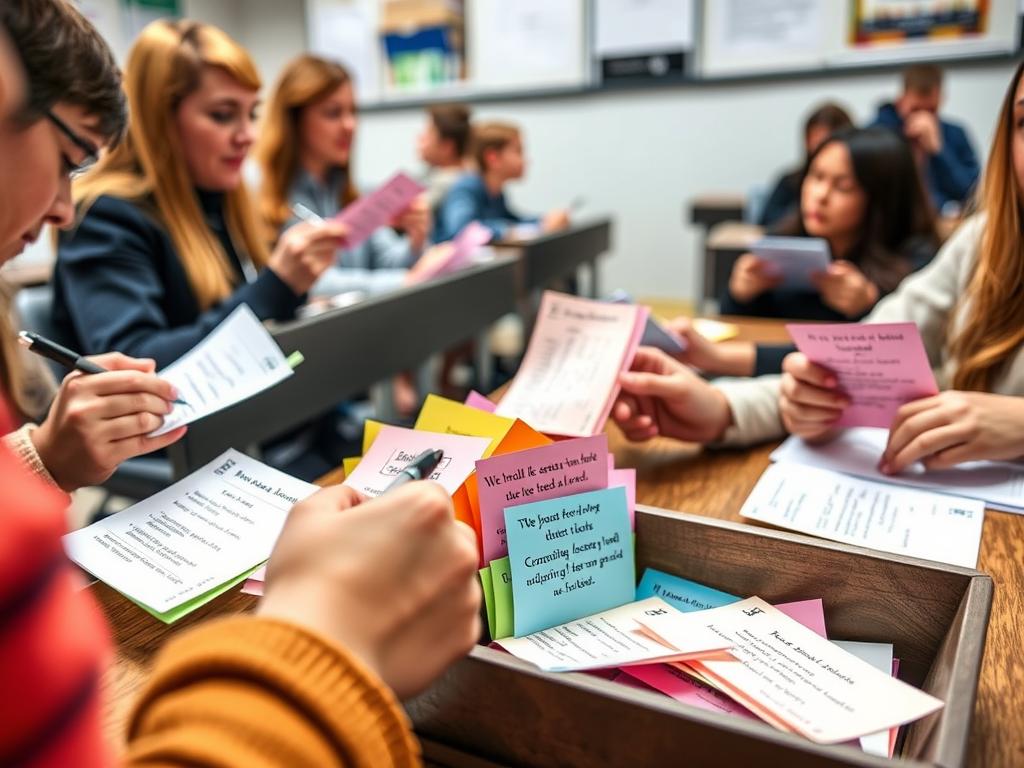
Exit tickets are among the most versatile formative assessment strategies in a teacher’s toolkit. These quick end-of-class assessments provide immediate feedback on student understanding while the day’s lesson is still fresh.
How to implement exit tickets effectively:
- Keep questions focused on the day’s key learning objective
- Limit to 1-3 questions that can be answered in under five minutes
- Use a variety of question types (multiple choice, short answer, visual representation)
- Collect as students leave the classroom
- Review before planning your next lesson
Exit tickets help you develop critical teacher skills like data analysis and responsive planning. By reviewing these quick assessments, you can identify which concepts need reinforcement and which students require additional support.
“I sort exit tickets into three piles: got it, almost there, and needs reteaching. This five-minute activity completely transforms my next day’s instruction.”
— Maria Sanchez, 5th Grade Teacher
Want to develop more advanced teacher skills in formative assessment? Our assessment courses provide deeper strategies for analyzing exit ticket data and using it to differentiate instruction effectively.
2. Think-Pair-Share: Collaborative Formative Assessment Strategies
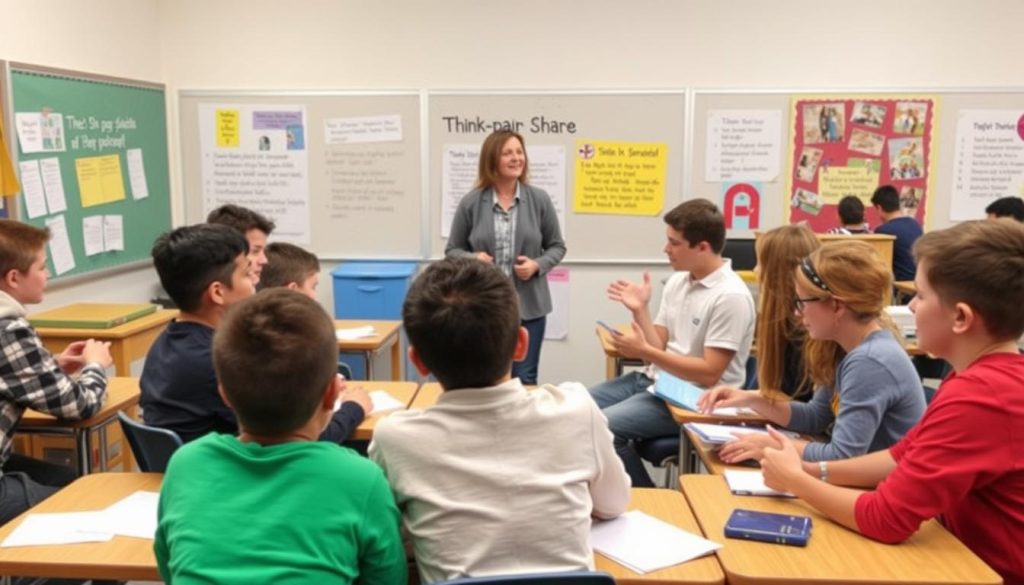
Think-Pair-Share is one of the most effective formative assessment strategies because it combines individual reflection with collaborative learning. This three-step approach gives you multiple opportunities to assess understanding while building students’ communication skills.
The Think-Pair-Share process:
Think
Students individually reflect on a question or problem, often writing down their thoughts.
Pair
Students discuss their ideas with a partner, comparing perspectives and refining their thinking.
Share
Selected pairs share insights with the whole class, allowing for broader discussion.
As you circulate during the “pair” phase, you’ll gather valuable formative data about student understanding. Listen for misconceptions, creative connections, and gaps in knowledge. This develops essential teacher skills in identifying learning needs through conversation rather than written work.
Pro Tip: Provide sentence starters to support productive discussions: “I noticed that…” “I wonder why…” “This connects to…” “I disagree because…”
Developing strong questioning techniques is a vital teacher skill that enhances the effectiveness of Think-Pair-Share. Our professional development courses offer specialized training in crafting questions that promote deeper thinking and reveal student understanding.
3. Digital Response Tools: Modern Formative Assessment Strategies

Digital response tools have revolutionized formative assessment strategies, allowing for instant data collection and analysis. These platforms transform how we gather evidence of student understanding, making assessment more efficient and engaging.
Popular digital formative assessment tools:
- Poll Everywhere: Create live polls students can answer via smartphones or computers
- Kahoot: Game-based assessment that increases engagement while checking understanding
- Mentimeter: Allows for word clouds, scales, and open-ended responses
- Google Forms: Create quick quizzes with automatic grading and data analysis
- Padlet: Digital bulletin board where students can post responses, questions, and reflections
Developing proficiency with digital assessment tools is an increasingly important teacher skill in today’s classrooms. These platforms not only make data collection easier but also provide visual representations of class understanding that can guide your instruction.
When using digital tools, always have a low-tech backup plan ready. Technical difficulties shouldn’t derail your formative assessment strategies.
Learning to effectively integrate technology into your assessment practices is a valuable teacher skill that can save time while providing richer data. Credits for Teachers offers specialized courses in educational technology that can help you master these digital formative assessment strategies.
Enhance Your Teacher Skills with Professional Development
Our specialized courses help you master formative assessment strategies while earning credits toward salary advancement. Learn practical techniques you can implement immediately in your classroom.
4. One-Minute Papers: Quick Written Formative Assessment Strategies
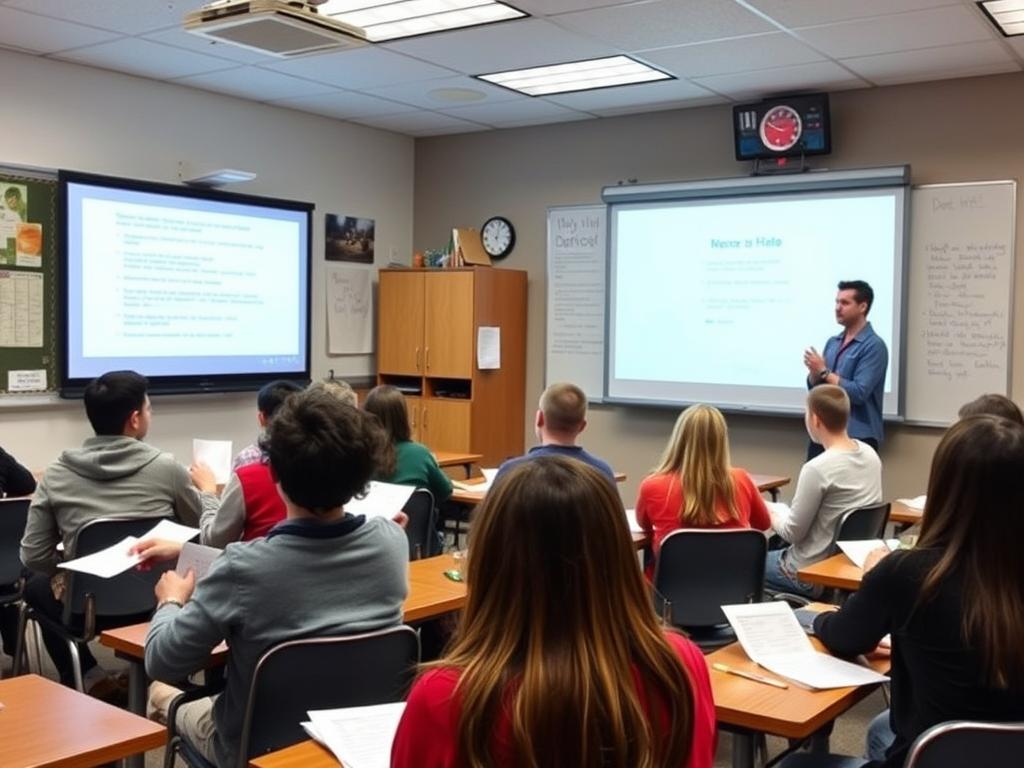
One-minute papers are among the most time-efficient formative assessment strategies available to teachers. These brief written responses require students to distill their understanding into concise statements, revealing their grasp of key concepts.
Effective prompts for one-minute papers:
- “What was the most important thing you learned today?”
- “What question remains unanswered for you?”
- “Explain [key concept] in your own words.”
- “How does today’s learning connect to what we studied last week?”
- “What was the muddiest point in today’s lesson?”
Analyzing one-minute papers develops critical teacher skills in quickly identifying misconceptions and knowledge gaps. By scanning these brief responses, you can adjust your next lesson to address common issues or extend learning for students who demonstrate mastery.
“One-minute papers transformed my teaching. They take almost no prep time but give me incredible insight into what my students actually understood versus what I thought I taught.”
— James Wilson, Middle School Science Teacher
Developing the teacher skill of crafting effective prompts is essential for maximizing the value of one-minute papers. Our assessment courses provide frameworks for creating prompts that elicit meaningful responses and reveal true understanding.
5. Visual Representations: Creative Formative Assessment Strategies
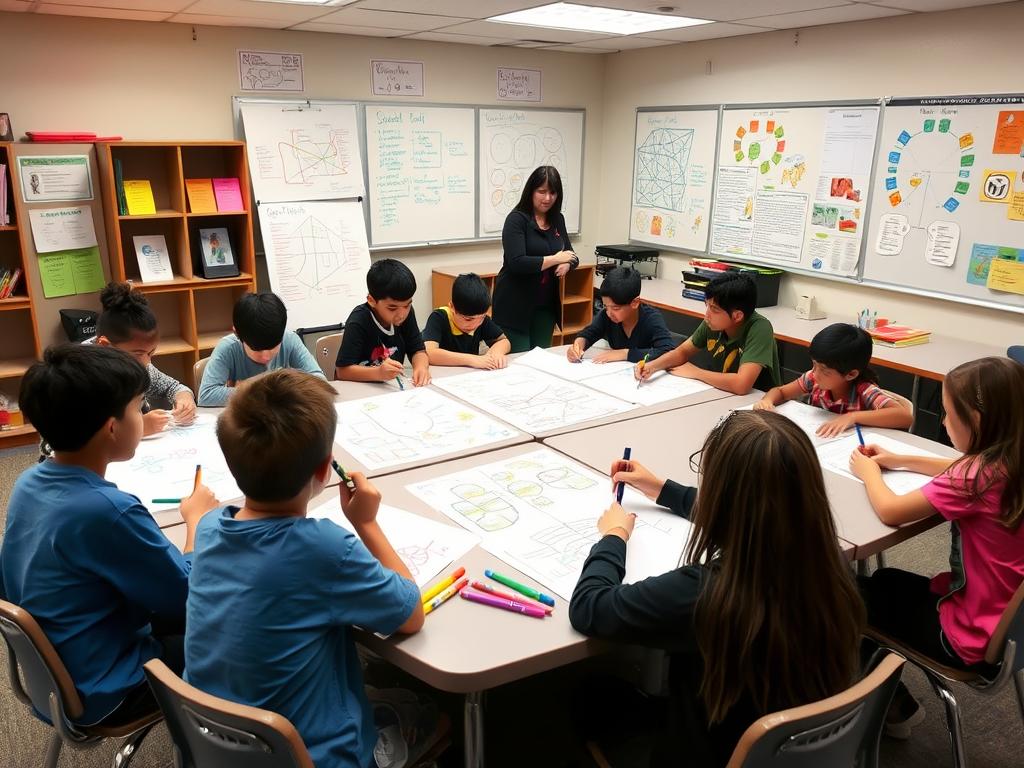
Visual representation activities are powerful formative assessment strategies that tap into different learning modalities. By asking students to create visual models of their understanding, you gain insight into how they’re organizing and connecting concepts in their minds.
Types of visual formative assessments:
Concept Maps
Students create diagrams showing relationships between concepts using circles/boxes and connecting lines.
Sketch Notes
Visual note-taking combining words, simple drawings, and organizational structures.
Flowcharts
Step-by-step visual representations of processes or sequences.
Venn Diagrams
Overlapping circles showing similarities and differences between concepts.
Interpreting visual representations develops important teacher skills in recognizing different ways students organize information. These formative assessment strategies often reveal connections or misconceptions that might not emerge through traditional written responses.
Implementation Tip: Start with simple visual templates and gradually introduce more complex formats as students become comfortable with visual thinking.
Learning to facilitate visual thinking is a valuable teacher skill that supports diverse learners. Credits for Teachers offers professional development opportunities that help you integrate visual formative assessment strategies across subject areas.
6. Four Corners: Movement-Based Formative Assessment Strategies
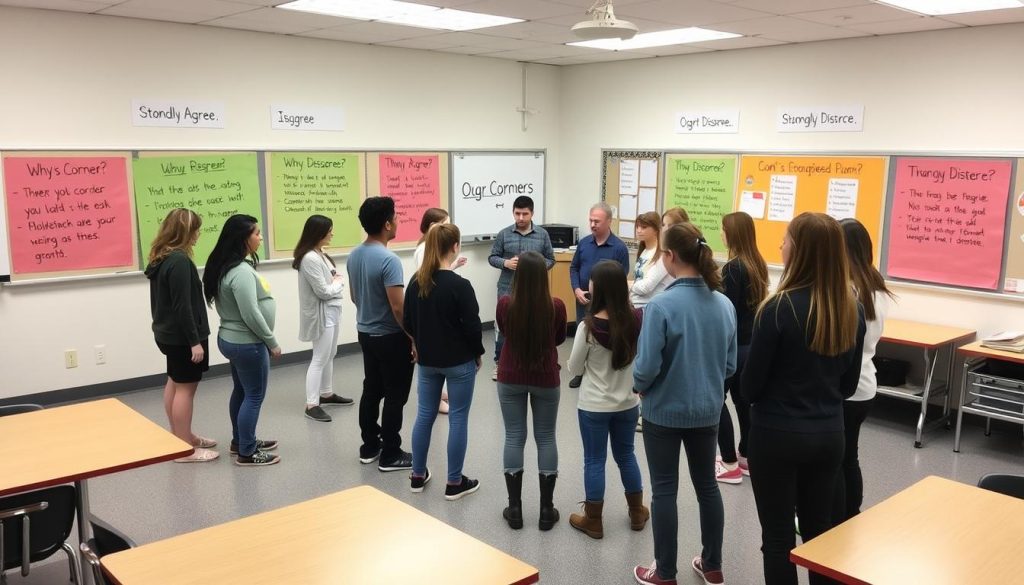
Four Corners is an energizing formative assessment strategy that gets students moving while revealing their thinking. This approach combines physical activity with critical thinking, making it particularly effective for kinesthetic learners and for breaking up longer lessons.
How to implement Four Corners:
- Label the four corners of your classroom with different responses (e.g., Strongly Agree, Agree, Disagree, Strongly Disagree)
- Pose a statement or question related to your learning objective
- Ask students to move to the corner that best represents their thinking
- Have students discuss their reasoning with others in their corner
- Invite representatives from each corner to share their group’s thinking
This strategy develops essential teacher skills in facilitating productive discussions and managing classroom movement. By observing which corners students choose and listening to their justifications, you gain valuable insights into their understanding and reasoning.
For students who may have mobility challenges, consider using response cards or having “ambassadors” who can physically move to represent the thinking of a small group.
Mastering movement-based formative assessment strategies is an important teacher skill that creates more engaging learning environments. Our professional development courses include modules on kinesthetic learning approaches that can enhance your assessment practices.
7. Self-Assessment Rubrics: Metacognitive Formative Assessment Strategies

Self-assessment rubrics are powerful formative assessment strategies that develop students’ metacognitive skills while providing you with insights into their perceived understanding. These tools help students reflect on their own learning progress and identify areas for improvement.
Elements of effective self-assessment rubrics:
- Clear, student-friendly language describing performance levels
- Specific criteria aligned with learning objectives
- Space for students to provide evidence supporting their self-ratings
- Opportunities for goal-setting based on self-identified areas for growth
- Comparison section where teacher assessment can be added later
Developing and implementing self-assessment tools builds important teacher skills in fostering student ownership of learning. When students regularly evaluate their own understanding, they become more independent learners and develop greater awareness of their strengths and challenges.
“The gap between how students rate themselves and how I would rate them tells me so much about their understanding—not just of the content, but of the expectations and their own learning process.”
— Elena Rodriguez, High School English Teacher
Creating effective rubrics is a sophisticated teacher skill that improves with practice and professional development. Credits for Teachers offers specialized courses in assessment design that can help you craft rubrics that promote meaningful self-reflection.
8. Strategic Questioning: Verbal Formative Assessment Strategies

Strategic questioning is perhaps the most fundamental of all formative assessment strategies, requiring minimal preparation while yielding rich insights into student thinking. The art of asking effective questions is a core teacher skill that develops with intentional practice.
Types of questions for formative assessment:
| Question Type | Purpose | Example |
| Probing | Uncover depth of understanding | “What evidence supports your conclusion?” |
| Clarifying | Address misconceptions | “Can you explain why you chose that approach?” |
| Connecting | Link concepts together | “How does this relate to what we learned last week?” |
| Hypothetical | Test application of concepts | “What would happen if we changed this variable?” |
| Metacognitive | Promote reflection | “What strategy did you use to solve this problem?” |
Developing strategic questioning techniques enhances your teacher skills in facilitating productive discussions and uncovering student thinking. By planning key questions in advance while remaining flexible to follow student responses, you create a classroom culture of thoughtful inquiry.
Wait Time Tip: After asking a question, count silently to 5-7 seconds before calling on students. This increased wait time leads to more thoughtful responses and greater participation.
Mastering the art of questioning is a sophisticated teacher skill that dramatically improves your formative assessment practices. Our professional development courses include specialized training in questioning techniques that promote deeper thinking and reveal student understanding.
Implementing Formative Assessment Strategies: Practical Considerations
Successfully integrating these formative assessment strategies into your daily teaching requires thoughtful planning and adaptation. Here are key considerations to help you implement these approaches effectively:
Benefits
- Provides immediate feedback on student understanding
- Allows for instructional adjustments in real-time
- Engages students in the assessment process
- Reduces test anxiety compared to summative assessments
- Builds metacognitive awareness in students
Challenges
- Requires quick analysis and decision-making
- May be difficult to document for grading purposes
- Some strategies require classroom management adjustments
- Students may need training to participate effectively
- Time constraints in content-heavy curricula
Tips for successful implementation:
- Start small—introduce one new formative assessment strategy at a time
- Create simple systems for recording insights (clipboard notes, digital forms)
- Establish clear routines so students know what to expect
- Use a variety of strategies to engage different learning styles
- Share the purpose with students so they understand the value
Developing efficient systems for implementing and analyzing formative assessments is an important teacher skill that improves with practice and professional development. Credits for Teachers offers courses specifically designed to help you integrate these strategies seamlessly into your teaching practice.
Advance Your Career While Enhancing Your Teacher Skills
Our specialized courses in formative assessment strategies help you become a more effective educator while earning credits toward salary advancement. Join thousands of teachers who have transformed their classrooms through our professional development programs.
Conclusion: Mastering Formative Assessment Strategies
Formative assessment strategies are essential tools in every educator’s toolkit. By implementing these eight approaches—exit tickets, think-pair-share, digital response tools, one-minute papers, visual representations, four corners, self-assessment rubrics, and strategic questioning—you create a responsive classroom environment where learning is continuously monitored and supported.
Developing these teacher skills not only enhances your instructional effectiveness but also creates more engaging learning experiences for your students. As you become more proficient with these formative assessment strategies, you’ll find yourself making more informed instructional decisions and better meeting the diverse needs of your learners.
Remember that mastering these approaches is a journey, not a destination. Continue to refine your teacher skills through practice, reflection, and professional development. Your investment in these formative assessment strategies will pay dividends in student engagement, achievement, and your own professional satisfaction.
Ready to take your assessment practices to the next level? Credits for Teachers offers specialized courses designed to help you master these strategies while advancing your career. Explore our offerings today and join a community of educators committed to excellence in teaching and learning.




